This is Part II of a three-part series.
If you missed it: GONZO GOZO: Azure Window Part I
 Before reaching Gozo, the ferry passes its tiny sister-island, Comino, nestling nearby in the Gozo Channel where in the mid-1500’s the Knights of Malta built a small tower as protection against the Ottoman Turks. I don’t quite understand the efficacy of these towers, but the Knights built a number of them on the main, inhabited islands of the archipelago.
Before reaching Gozo, the ferry passes its tiny sister-island, Comino, nestling nearby in the Gozo Channel where in the mid-1500’s the Knights of Malta built a small tower as protection against the Ottoman Turks. I don’t quite understand the efficacy of these towers, but the Knights built a number of them on the main, inhabited islands of the archipelago.
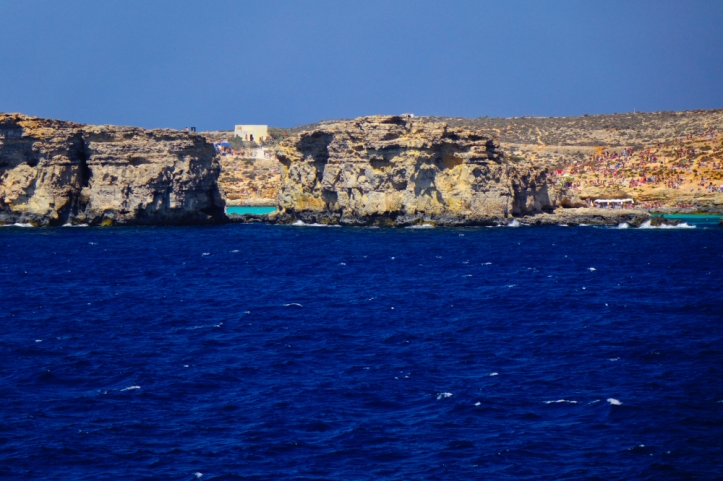 If you stay awhile on Gozo, taking the fast ferry to Comino from Gozo makes a charming day trip to visit their famous Blue Lagoon. But just so you know, it’ll cost you more for this short trip to Comino than it does for the ferry from Malta to Gozo. However, if you love to swim in crystalline pools and take selfies with a body of green water and a tribe of tourists as your backdrop, the Blue Lagoon is a righteous spot.
If you stay awhile on Gozo, taking the fast ferry to Comino from Gozo makes a charming day trip to visit their famous Blue Lagoon. But just so you know, it’ll cost you more for this short trip to Comino than it does for the ferry from Malta to Gozo. However, if you love to swim in crystalline pools and take selfies with a body of green water and a tribe of tourists as your backdrop, the Blue Lagoon is a righteous spot.
Advice du jour: bring a picnic lunch. Perhaps include a traditional dish, like timpana, a baked, nicely-spiced macaroni casserole that effectively demands you overeat. Maybe slip in some pastizzi, the light and addictive pastry filled with ricotta cheese. And a bottle of renowned local wine—you’ll find Maltese wine in only a few foreign countries. And the good stuff, only here.
Magical Mgarr
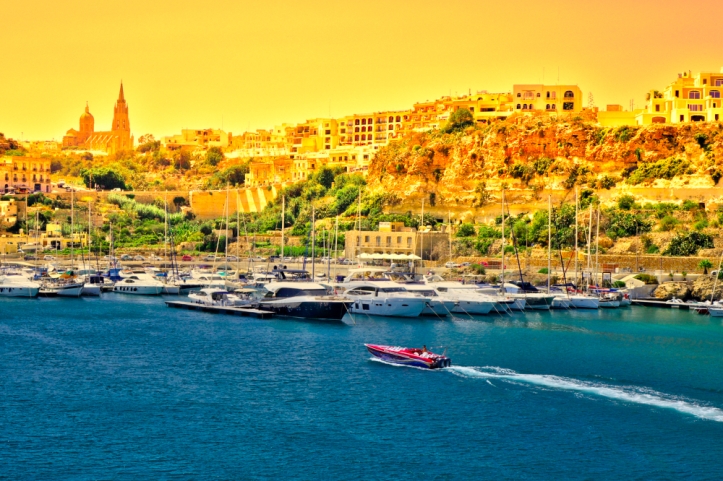 As the ferry approaches the port of Mgarr (pronounced Mgarr), it almost feels as though we’re entering another epoch in history—if you look past the cigar boats, dive shops, Astin Martin Roadster, Captain Morgan red tour boats, and all the yachts in the harbor.
As the ferry approaches the port of Mgarr (pronounced Mgarr), it almost feels as though we’re entering another epoch in history—if you look past the cigar boats, dive shops, Astin Martin Roadster, Captain Morgan red tour boats, and all the yachts in the harbor.
 Once I debark the ferry, I wind my way through town and climb the steep hill out of Mgarr to reach higher ground. You won’t need Google voice maps for this, just look for the road that goes “up.” Imagine Gozo as a giant wedge of cheddar cheese. This westerly side of the island is the wide, vertical plane of the wedge.
Once I debark the ferry, I wind my way through town and climb the steep hill out of Mgarr to reach higher ground. You won’t need Google voice maps for this, just look for the road that goes “up.” Imagine Gozo as a giant wedge of cheddar cheese. This westerly side of the island is the wide, vertical plane of the wedge.
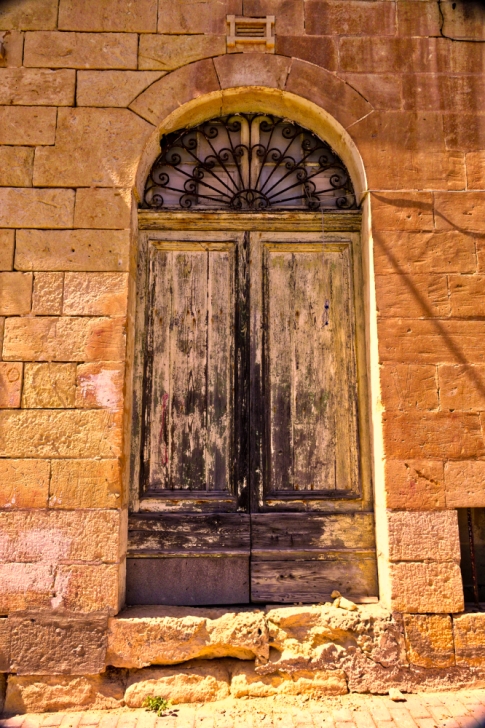 I find it almost impossible to walk past a beguiling door and not photograph it, especially an ill-kept door sunk in a ramshackle limestone wall with an arch of iron filigree above—where sometimes I actually think: if only doors could talk.
I find it almost impossible to walk past a beguiling door and not photograph it, especially an ill-kept door sunk in a ramshackle limestone wall with an arch of iron filigree above—where sometimes I actually think: if only doors could talk.
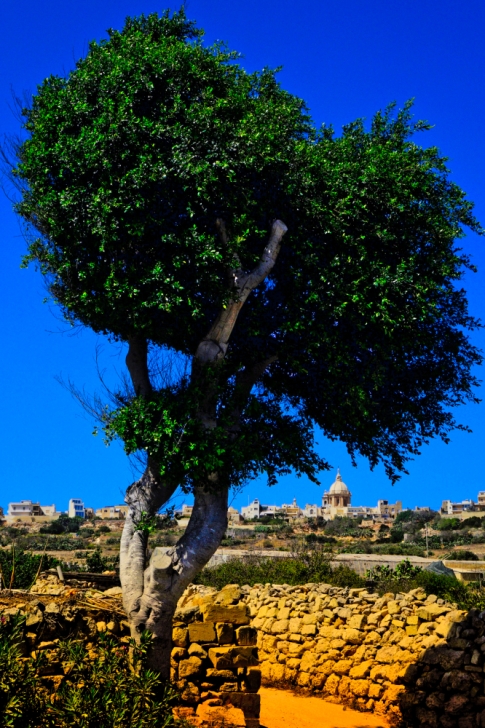 I harbor the same issue with trees, especially twisted cedars or cypress, or the rare and endangered Gharghar—a gum, and national tree of Malta. Locals say it’s uncommon to find one in the wild and is found nowhere else in Europe. The tree naturally emanates a resin from its branches that was used as a wood varnish in the 1500’s, when the tree flourished in abundance here.
I harbor the same issue with trees, especially twisted cedars or cypress, or the rare and endangered Gharghar—a gum, and national tree of Malta. Locals say it’s uncommon to find one in the wild and is found nowhere else in Europe. The tree naturally emanates a resin from its branches that was used as a wood varnish in the 1500’s, when the tree flourished in abundance here.
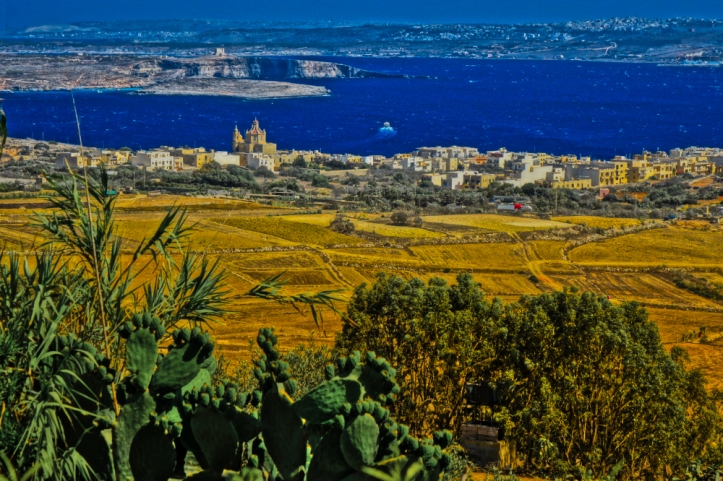 Heading inland toward the village of Nadur, I discover impressive views on high ground—Gozo’s semi-arid flora, with the Blue Lagoon and the Knights of Malta tower on Comino to the left, and Malta beyond.
Heading inland toward the village of Nadur, I discover impressive views on high ground—Gozo’s semi-arid flora, with the Blue Lagoon and the Knights of Malta tower on Comino to the left, and Malta beyond.
Even though it’s a small village, you might want to use your turn-by-turn voice map while traveling through Nadur: I get lost again trying to find my way to Route 15 leading to Ramla Bay on Gozo’s thin side of the wedge.
Ramla Bay
 It is a beach resort, so you will find Ramla Bay precisely as you’d expect: sunburned tourists being tourists on vacation wearing sunglasses, shorts, tank tops and thongs, carrying beach towels smelling like coconut SPF-15. And some, driving quads or Honda motorbikes.
It is a beach resort, so you will find Ramla Bay precisely as you’d expect: sunburned tourists being tourists on vacation wearing sunglasses, shorts, tank tops and thongs, carrying beach towels smelling like coconut SPF-15. And some, driving quads or Honda motorbikes.
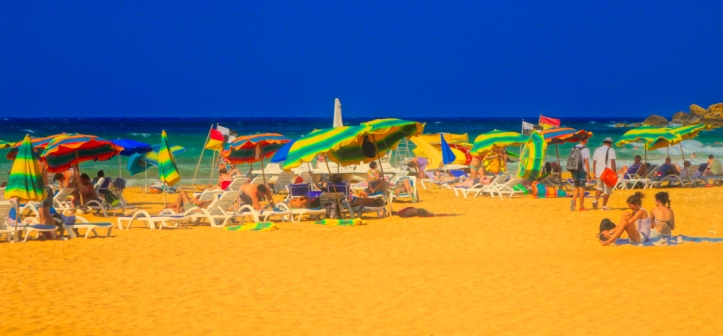 If you bring a swimsuit, Ramla Bay is a brilliant spot to sit under an umbrella in the (cheddar-colored) sand and enjoy the unspoiled vibes at the ocean. However, you may want to check the surf conditions: a sunny day does not always mean a calm sea here at the virtual center of the Mediterranean, almost 60 miles due south of Sicily in waters up to 2000 feet deep where a pleasant breeze swiftly shifts into gale-force winds.
If you bring a swimsuit, Ramla Bay is a brilliant spot to sit under an umbrella in the (cheddar-colored) sand and enjoy the unspoiled vibes at the ocean. However, you may want to check the surf conditions: a sunny day does not always mean a calm sea here at the virtual center of the Mediterranean, almost 60 miles due south of Sicily in waters up to 2000 feet deep where a pleasant breeze swiftly shifts into gale-force winds.
Note to self: research why sand in the Maldives is white, and here on Gozo, cheddar-ish.
 Ramla Bay has no town, so the extent of tourist trappings is minimal, oddly—or rather, thankfully. You can buy burgers and ice cream from food trucks parked along the road leading to the beach.
Ramla Bay has no town, so the extent of tourist trappings is minimal, oddly—or rather, thankfully. You can buy burgers and ice cream from food trucks parked along the road leading to the beach.
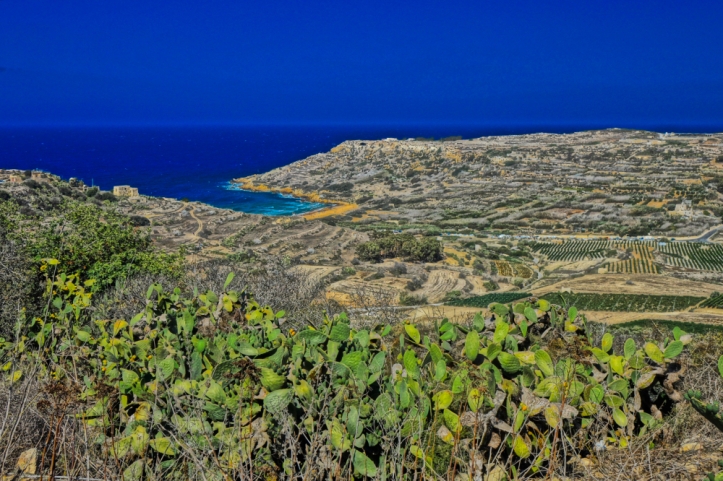 If you’ve rented a dune buggy, you might take a short cut from Ramla Bay and climb the mountain on dirt roads. If you’ve rented and been artfully overcharged for your G rental car by a villain named, let’s say, Fagin, you follow the road through fruit-bearing cactus groves that leads uphill to the cave where Calypso held Odysseus captive all those years.
If you’ve rented a dune buggy, you might take a short cut from Ramla Bay and climb the mountain on dirt roads. If you’ve rented and been artfully overcharged for your G rental car by a villain named, let’s say, Fagin, you follow the road through fruit-bearing cactus groves that leads uphill to the cave where Calypso held Odysseus captive all those years.
Calypso’s Cave
 At the top, I find an imposing view at Calypso’s Cave. A word of caution about legends like this: accept them maybe, but harbor a smidgeon of skepticism.
At the top, I find an imposing view at Calypso’s Cave. A word of caution about legends like this: accept them maybe, but harbor a smidgeon of skepticism.
I mean, they’re saying this lithe, little nymph—cunning perhaps, but certainly no Medusa or Minotaur — held captive for like seven years one of the greatest travelers, and warriors, of all time to use as her boy toy. Was she a witch? Possess superhuman powers? Cast magic spells? Or was she like this ravishing beauty, maybe younger and prettier and a better cook than his wife, and when Odysseus finally arrived home to Penelope, he sort of stretched the truth about being “held captive and praying to the gods for release” when it was more like a “time-flying-while-having-a-good-time” affair.
I’m certainly not trying to de-myth a legend, you understand. I’m just saying men have always been men, and in those days…maybe, even more so. And we all know what women are capable of.
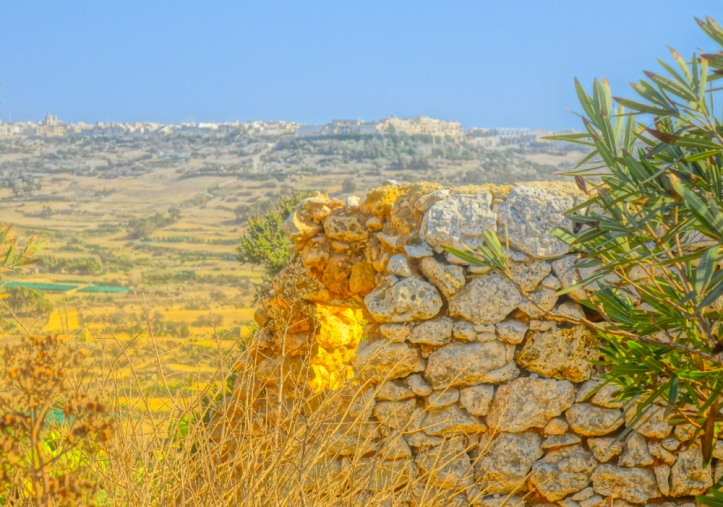 I discover a limestone structure huddled on the hill above the cave. I’m pretty sure Odysseus built it, and this—not some cave with bats and rats and lice and open to the elements—is where he and Calypso hung out until Zeus eventually answered the prayers and—ahem—forced her to let him go.
I discover a limestone structure huddled on the hill above the cave. I’m pretty sure Odysseus built it, and this—not some cave with bats and rats and lice and open to the elements—is where he and Calypso hung out until Zeus eventually answered the prayers and—ahem—forced her to let him go.
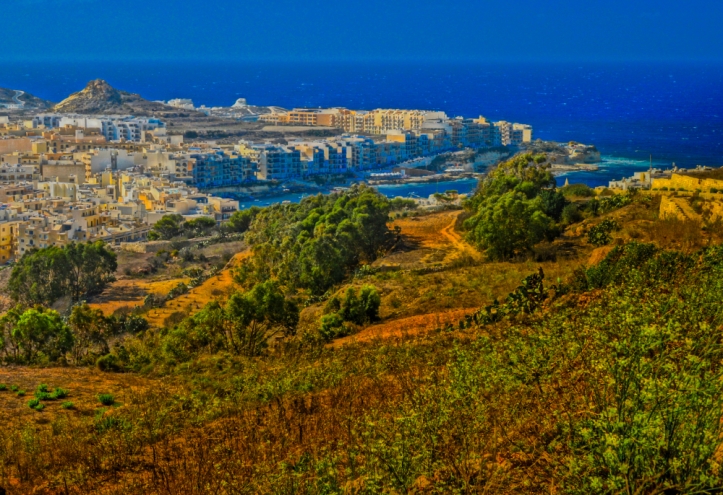 After leaving Calypso Cave, I wind my way through striking valleys and stark plateaus toward Marsalforn Bay.
After leaving Calypso Cave, I wind my way through striking valleys and stark plateaus toward Marsalforn Bay.
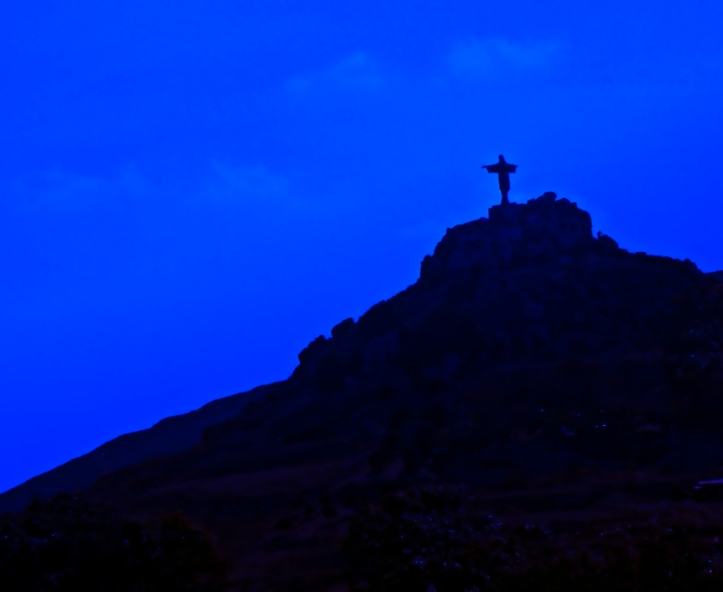 If you’re a hiker, Gozo is a walkable island — about 9 miles long and 4 wide. You could fit four Gozos in the town of Las Vegas. Near Marsalforn, I pass the Gozitan version of Christ the Redeemer, a miniature modeled after the original in Brazil, which befits the size of the island.
If you’re a hiker, Gozo is a walkable island — about 9 miles long and 4 wide. You could fit four Gozos in the town of Las Vegas. Near Marsalforn, I pass the Gozitan version of Christ the Redeemer, a miniature modeled after the original in Brazil, which befits the size of the island.
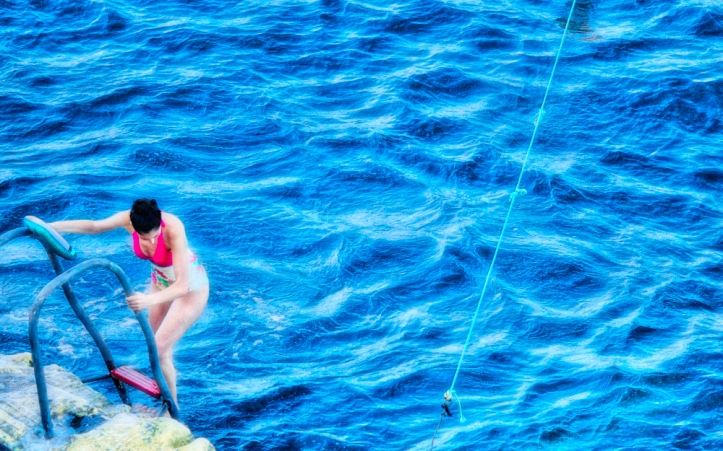 At some places on Gozo, it’s easier to “dunk” yourself into the ocean from a protected, yet rocky shore rather than wade through thrashing waves, like this spot in Marsalforn Bay just off Triq Santa Marija. Triq is Maltese for street, or way.
At some places on Gozo, it’s easier to “dunk” yourself into the ocean from a protected, yet rocky shore rather than wade through thrashing waves, like this spot in Marsalforn Bay just off Triq Santa Marija. Triq is Maltese for street, or way.
 If you keep driving, or walking, along the coast on Triq Santa Marija, you’ll have nice views across Qbajjar Bay. If you’re overnighting or staying for a longer time, this is a comfortable area to use as a base camp, or chill—quiet, clean, ocean breezes, fine dining, reasonable rooms, accommodating but uncrowded, no McDonalds, no ferry traffic.
If you keep driving, or walking, along the coast on Triq Santa Marija, you’ll have nice views across Qbajjar Bay. If you’re overnighting or staying for a longer time, this is a comfortable area to use as a base camp, or chill—quiet, clean, ocean breezes, fine dining, reasonable rooms, accommodating but uncrowded, no McDonalds, no ferry traffic.
 A little further along the coast, I pass the Qolla l-Bajda, a military battery used by the Knights during the 1500’s to house artillery and weapons.
A little further along the coast, I pass the Qolla l-Bajda, a military battery used by the Knights during the 1500’s to house artillery and weapons.
You’ll also find interesting examples of how the elements of nature deftly shape the rock and sculpt the landscape here. The road is well maintained along the bay, but a little further on, you might need one of those four-wheelers to continue over to Wied il-Ghasri, an enchanting ravine carved out of rock.
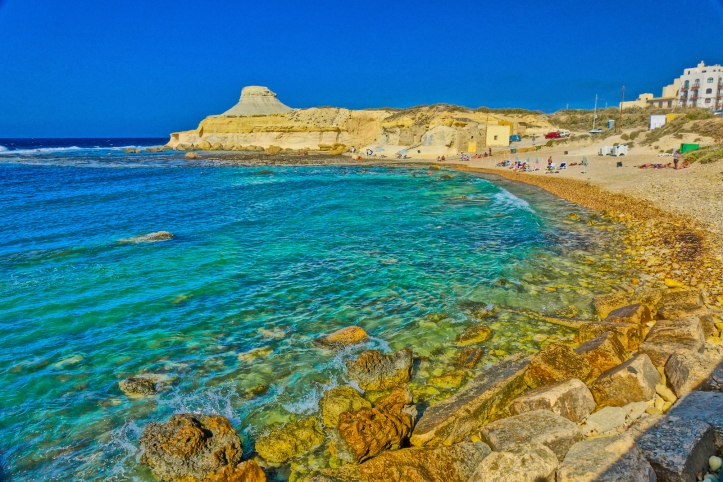 When the Ottoman’s attacked Gozo in 1551, they vastly outnumbered the locals and fairly swiftly seized control of the island, then shipped the Gozitans, and remaining Knights, off to Tripoli—a little over 200 miles due south—and sold them into slavery, many departing from Xwejni Bay.
When the Ottoman’s attacked Gozo in 1551, they vastly outnumbered the locals and fairly swiftly seized control of the island, then shipped the Gozitans, and remaining Knights, off to Tripoli—a little over 200 miles due south—and sold them into slavery, many departing from Xwejni Bay.
Salt Pans
 I meander a little further along the Xwejni coast and discover a vast array of salt pans used for harvesting sea salt; the “pans” are chiseled out of the rock at the water’s edge and run a good three kilometers up the coast. Some of the salt pans have been used since Roman times and are now operated by a number of families who’ve worked them traditionally for over three centuries.
I meander a little further along the Xwejni coast and discover a vast array of salt pans used for harvesting sea salt; the “pans” are chiseled out of the rock at the water’s edge and run a good three kilometers up the coast. Some of the salt pans have been used since Roman times and are now operated by a number of families who’ve worked them traditionally for over three centuries.
After the water evaporates, the salt solidifies into thick grains in the pan. The collectors use wide-head push brooms to sweep the salt into piles, then scoop it up and store it in caves carved into limestone cliffs along the coast. Talk about a low-tech, low-overhead business.
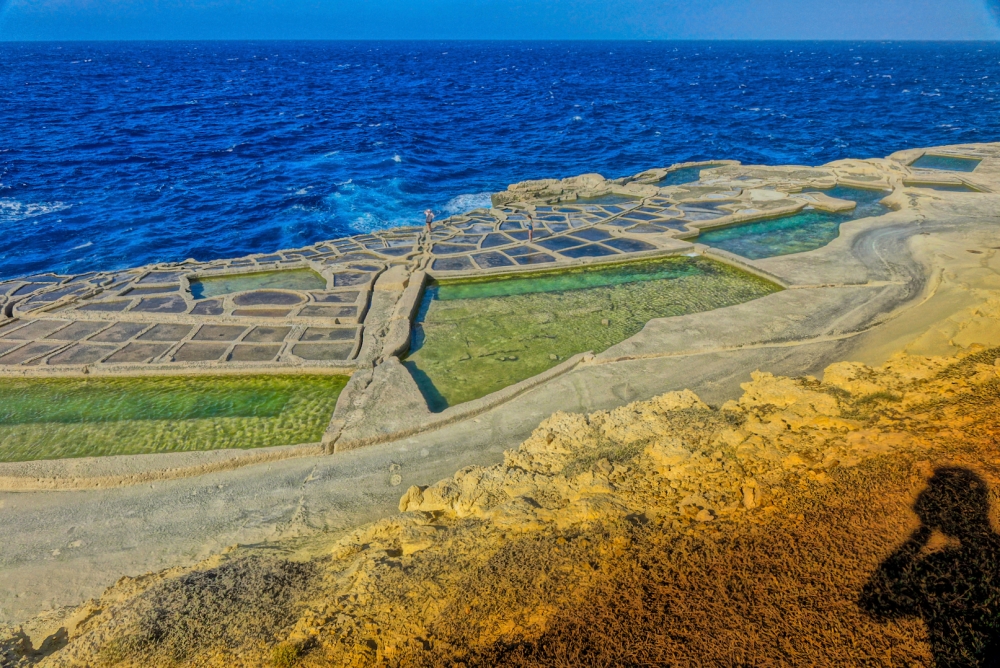 Posted signs request you not walk on the salt pans (nobody wants thong jizz in their salt). But obviously, some tourists cannot resist the temptation for some reason—one might surmise, it’s those low-rent-not-desired-in-Bhutan-for-this-very-reason types.
Posted signs request you not walk on the salt pans (nobody wants thong jizz in their salt). But obviously, some tourists cannot resist the temptation for some reason—one might surmise, it’s those low-rent-not-desired-in-Bhutan-for-this-very-reason types.
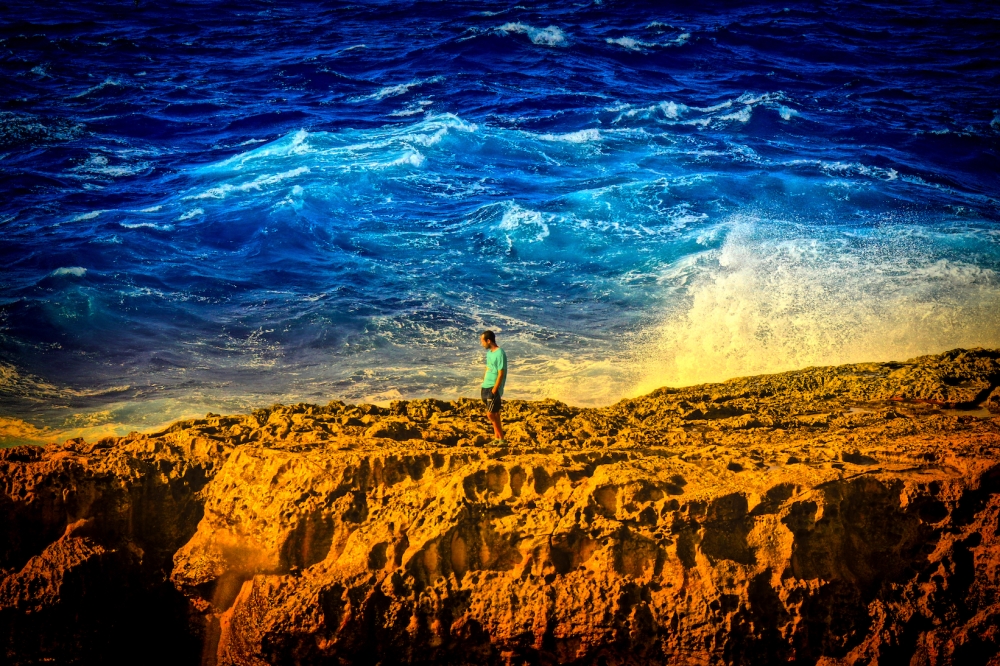 Walking a bit further along Xwejni Bay, just past the salt pans, I arrive at Recca Point. If the weather is right and the winds pick up, you easily sense the power of Mother Nature’s repertoire of elements, and you may linger a while to imbibe the milieu of forces ravaging the shore. You might begin to feel as though you’ve become one with the energy—water, wind, rock all merging into an intense visceral emotion. Perhaps, the kind of place gods and nymphs hang out, or speak to you. Or maybe…are created.
Walking a bit further along Xwejni Bay, just past the salt pans, I arrive at Recca Point. If the weather is right and the winds pick up, you easily sense the power of Mother Nature’s repertoire of elements, and you may linger a while to imbibe the milieu of forces ravaging the shore. You might begin to feel as though you’ve become one with the energy—water, wind, rock all merging into an intense visceral emotion. Perhaps, the kind of place gods and nymphs hang out, or speak to you. Or maybe…are created.
Wied il-Ghasri
If you’re walking—or driving a dune buggy, or your G rental car you’ve paid an ogre twice for insurance (right, muffle the whinging)—you can take the dirt road along the coast over to Wied il-Ghasri. The road here almost looks like you won’t be able to drive it, but you can.
 I travel another kilometer or so along Triq Is-Saghtrija, and discover the remote and interesting valley of Ghasri. When the water is smooth and tranquil, the guidebooks say this is an exquisite spot to swim and snorkel. Today, the water is anything but smooth and tranquil. Five- to six-foot waves careen through the narrow ravine and break against the rocky beach with a dissonant rumbling sound.
I travel another kilometer or so along Triq Is-Saghtrija, and discover the remote and interesting valley of Ghasri. When the water is smooth and tranquil, the guidebooks say this is an exquisite spot to swim and snorkel. Today, the water is anything but smooth and tranquil. Five- to six-foot waves careen through the narrow ravine and break against the rocky beach with a dissonant rumbling sound.
 Someone at some point actually built a stone stairway down to the bottom—because without the steps, I’m surmising, this would be a fairly ambitious and dangerous location to access, and too many adventuresome pilgrims got hurt trying (right, despite signs being posted).
Someone at some point actually built a stone stairway down to the bottom—because without the steps, I’m surmising, this would be a fairly ambitious and dangerous location to access, and too many adventuresome pilgrims got hurt trying (right, despite signs being posted).
 Even with the stairway, the only people here today are a handful of millennial vagabonds. Some in thongs, some topless, all with body art. Just so you know: this is not whinging—who doesn’t love perusing attractive tats.
Even with the stairway, the only people here today are a handful of millennial vagabonds. Some in thongs, some topless, all with body art. Just so you know: this is not whinging—who doesn’t love perusing attractive tats.
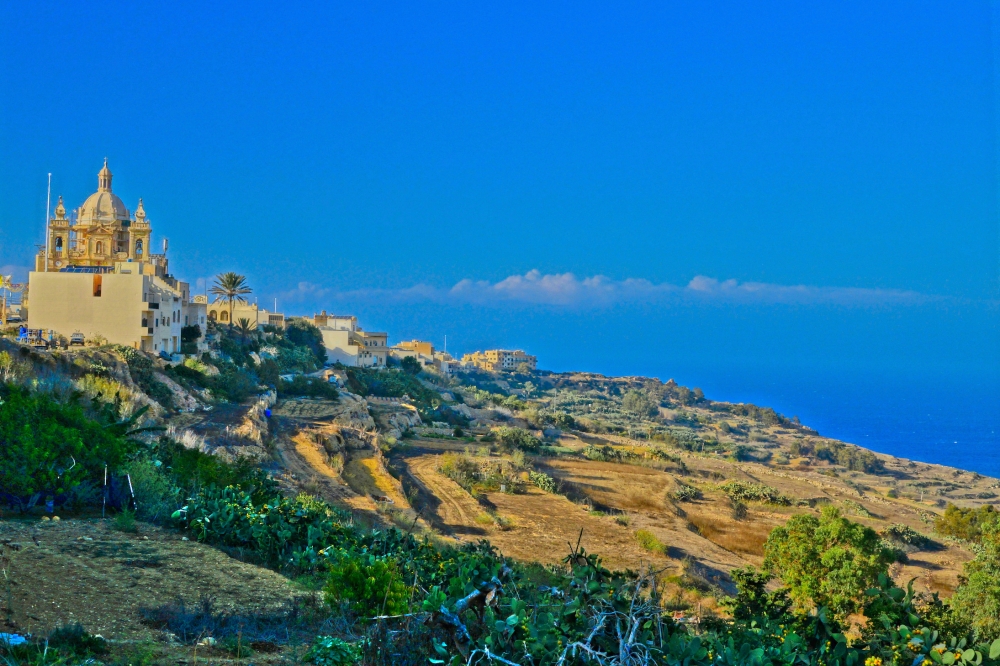 After leaving Wied il-Ghasri, I begin climbing the long hill up to the classic burg of Zebbug. If you’re on foot, it’ll take a while. If you’re in a dune buggy, try not to ruin the terraced vegetable fields. In my twice-insured G rental car, I begin forming one more rationalization: when justice is unlikely, vengeance may be justified. I imagine hitting every garbage can I pass, or maybe testing my skill at scratching only the bottom third of the side of the car on roadside brambles.
After leaving Wied il-Ghasri, I begin climbing the long hill up to the classic burg of Zebbug. If you’re on foot, it’ll take a while. If you’re in a dune buggy, try not to ruin the terraced vegetable fields. In my twice-insured G rental car, I begin forming one more rationalization: when justice is unlikely, vengeance may be justified. I imagine hitting every garbage can I pass, or maybe testing my skill at scratching only the bottom third of the side of the car on roadside brambles.
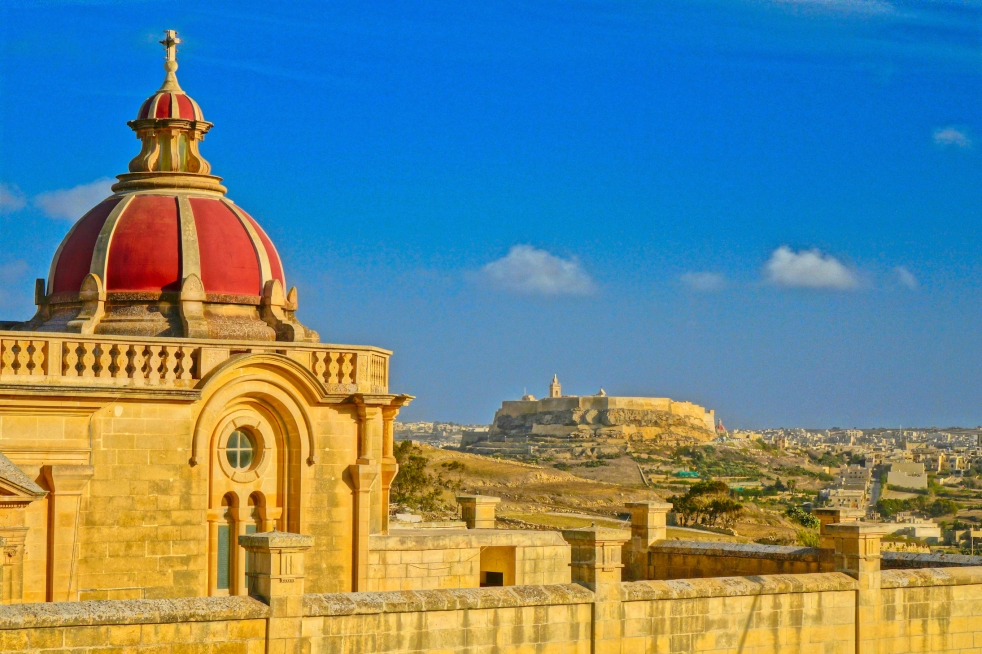 While traveling along Triq il Fanal heading west, I find it curious that on an island the size of Provincetown at the tip of Cape Cod and housing a population less than Bozeman, Montana, there are almost 50 churches. In the distance, the bulwark of the ancient walled city of Rabat, the capital of Gozo, rises majestically on high ground.
While traveling along Triq il Fanal heading west, I find it curious that on an island the size of Provincetown at the tip of Cape Cod and housing a population less than Bozeman, Montana, there are almost 50 churches. In the distance, the bulwark of the ancient walled city of Rabat, the capital of Gozo, rises majestically on high ground.
It was renamed Victoria by the British in the 1700’s, but most locals still call it Rabat, Arabic for “bond” or “unity” which makes sense because until the mid-1700’s everyone on Gozo slept inside the ramparts of Rabat—required by law, due to the ruthless raids by Turkish, and other, marauders over the centuries. And yet the name seems odd, or ironic, to me because “rabat” is Arabic, the very people who attacked at one point and took control of the islands and renamed it Rabat after being inhabited since Neolithic times.
Ta Pinu
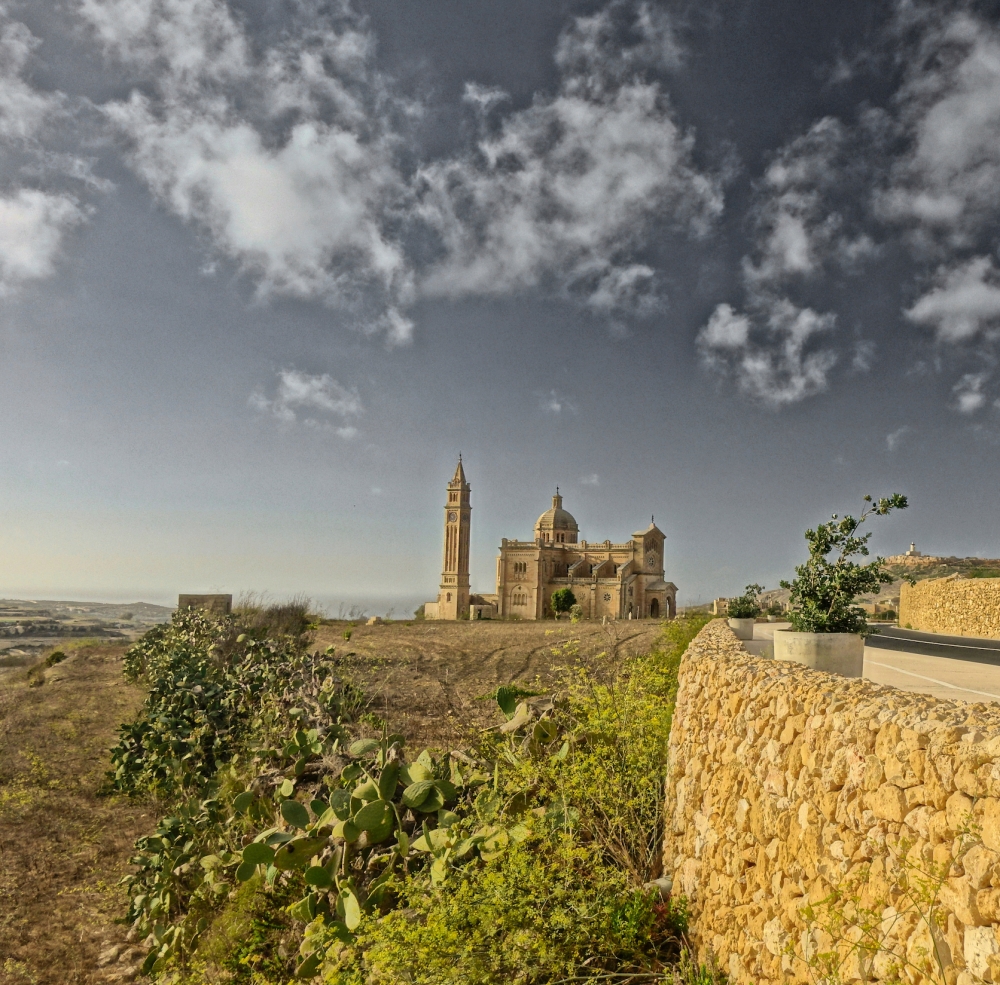 I drive leisurely on Triq Pinu toward the town of Gharb heading for the popular holy shrine and pilgrimage basilica of Ta’ Pinu, built in the 16th century out of the ubiquitous local limestone you see everywhere on the island. It seems interesting that the architects constructed the bell tower as a campanile, a completely separate structure from the church—like the leaning tower of Pisa, also a separate church bell tower—which is how they were built at that time, and only later became integrated into the main structures.
I drive leisurely on Triq Pinu toward the town of Gharb heading for the popular holy shrine and pilgrimage basilica of Ta’ Pinu, built in the 16th century out of the ubiquitous local limestone you see everywhere on the island. It seems interesting that the architects constructed the bell tower as a campanile, a completely separate structure from the church—like the leaning tower of Pisa, also a separate church bell tower—which is how they were built at that time, and only later became integrated into the main structures.
If you’re walking, you’ll discover it peaceful in this area of the island. While driving along this stretch, I begin to understand why the guidebooks say it’s “fun to drive on Malta” even though on the wrong side of the street: there’s limited traffic on open roads, streets are fairly-well maintained, outrageous scenery in any direction, unique landscapes, vistas to the blue horizon, and I begin to feel the rare inner quality—when traveling, the very-rare quality—of freedom blended with a sense of security.
When I arrive at Our Lady of Ta Pinu, the parking lot is almost full, with more cars arriving. I figure something is up, and hope I’ll see some sort of festival, or ceremony, or miracle. Turns out, it is time for evening mass. I refrain from going inside to photograph the sacred site where a Maltese woman heard the voice of Mother Mary years ago and where two popes have visited and blessed the site of the miracle.
But a pilgrimage is a pilgrimage, and I have my own to complete. So I continue toward the not-exactly-holy grail on this quest — a visit to the exceptional Azure Window on Gozo’s Dwejra Coast, a handsome natural heritage site just a few kilometers down the road from Ta Pinu.
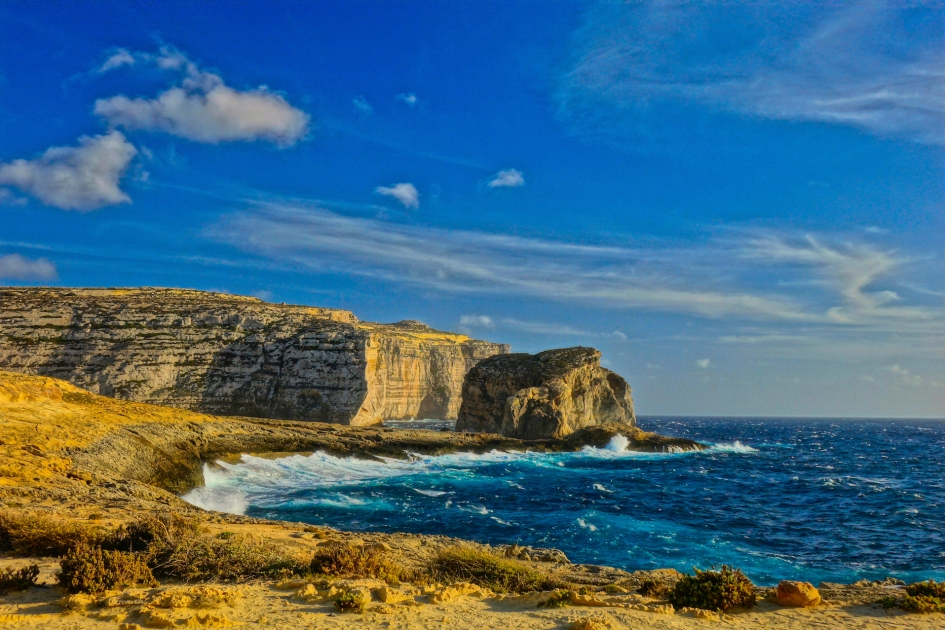 As I near the water and look south, I notice another view of the thick side of the cheddar wedge at Dwejra Bay, and the limestone cliffs along the Dwejra coastline, created when the African tectonic plate slipped under the Eurasian plate, and moved ¾ of an inch north each year for the past 100 million years or so.
As I near the water and look south, I notice another view of the thick side of the cheddar wedge at Dwejra Bay, and the limestone cliffs along the Dwejra coastline, created when the African tectonic plate slipped under the Eurasian plate, and moved ¾ of an inch north each year for the past 100 million years or so.
A small piece of my ego would like to high-five a triumph, and boast a long and arduous trek across Malta and all the way to the other side of Gozo on this adventure (although without extracting vengeance).
Truth is, the guidebooks were right—driving here is fun. And easy. And get this: you can drive right up to Gozo’s solitary, wild west coast, and park your car 100 meters from the water and the majestic Azure Window.
It gets even better: if you’re hungry by now, you can eat dinner at the not-exactly-cheap-but-pleasant-with-a-sunset-view Azure Window Restaurant located here at the end of the road in the middle of nowhere.
Hint du jour: order the timpana and some pastizzi. A glass of pinot. Chocolate baci for dessert.
This is Part II of a three-part series. If you missed it: GONZO GOZO: Azure Window Part I
YOU ARE HERE:
More on Malta: ANOTHER SIDE OF MALTA: DAY ONE
See more DP Photo Challenge: Surprise” target=”_blank”>Surprise
See more WP Daily Prompts: Measure” target=”_blank”>Measure

A great report on Gozo. Loved it there but was sorry to have missed seeing the Azure Window as it fell into the sea a few days before we got there. I saw where it was.
LikeLiked by 1 person
I’ve got a few photos of it coming up…and my memory (for now).
LikeLiked by 1 person
Excellent views, a bit stalkerish some of them. Not so clear how much of Cheddar colour your added in post-production. Impressed with how they spell “Marija”. Like us, Slovenians. Why?
LikeLiked by 1 person
I wouldn’t call it “stalkerish” you know. I mean, it’s more like “luck” to happen upon stuff like that. I wasn’t tailing nobody. And not as lucky as some who always seem to get cool shots of people in their shots. I hate those guys.
LikeLiked by 1 person
Oh, wrong word, I meant “lurking”. I wouldn’t suggest that you tailed anybody, but merely looked and there they were. I know cause I have some of those too. 🙂 Unless you direct the people, it’s all luck in any case: I bet those guys just take a million shots and then only show the lucky ones.
LikeLike
Beautiful! We love Gozo too and although it was only a day trip, thoroughly enjoyed it.
You made reference to the towers. Could they had been outposts to warn the mainland of any impending attack through fire signals?
LikeLike
I would go back to Gozo in a flash, and stay a few months…and do nothing. Except walk the island. I’m really just not sure how they utilized those towers…I assumed they were like tiny forts where knights slept or holed up and kept their weapons dry. But yeah…early warning probably, also.
LikeLiked by 1 person
Yeah we can imagine. Its sto tiny and cramp. And the knights were dressed in like all that armour…
LikeLike
Quite a full range of scenery, history, and geology in that one small area, it seems. That would be a perfect day for me, driving around, stopping for a hike or two, capturing scenes big and small and oh so colorful! There really is nothing like Mediterranean light, on both the old stone and the blue sea; I’m still thinking about summer plans, and this is nudging me that direction.
LikeLike
You could do it in a day, but it’s such a nice place, I’d like to spend a few months there, just soaking up the vibes. And I do like the light there also, but I really like the light in Australia…something about that latitude?
LikeLiked by 1 person
Marvelous images and text, as always.
LikeLike
Thanks Sally…I think most of these were with my camera, but I just got an iPhone 7+, so am expecting good things in the future from that thing.
LikeLike
That new part of your photographic tool kit will probably become a steady companion.
LikeLike
Okay so the entire post makes me want to go explore Malta. And your photos this time are spectacular! But where in hell is the picture of the azure window?????!!!!! I’m waiting and waiting and waiting to get to the end to see it and it’s not there! Cruel and unusual punishment! Off to google now 🙂
Alison
LikeLike
Alison…ha! I like a couple of these shots a lot, the ones with water. And it’s funny, I was going to publish this as one story, not three parts, but it kept getting longer and longer. I think it’s better to read it as one story, but I couldn’t finish it. So I hope you found a shot of the Azure Window online.
LikeLiked by 1 person
I did. It collapsed very recently so no longer exists.
LikeLike
exactly…8 March…I can’t remember what (or if) I ate for breakfast today, but I can’t seem to forget that date. It was quite an experience for me, more than just a sighting of the place, more than just a visit. The coastline is magical.
LikeLiked by 1 person
And I just have to say that the photo of Ta Pinu is truly spectacular. And that thew azure window doesn’t exist anymore.
Alison
LikeLiked by 1 person
Oh yeah, Ta Pinu…I like that photo, too…the sky and the stark earth. And yeah, sad thing about icons…sometimes, they disappear. If you go to Gozo, you won’t be able to see the Azure Window. But still a great spot.
LikeLiked by 1 person
There’s a wonderful golden-ness to it all! I think I could become besotted. But you do have a point about the sand. Geologists would have the earth erupting/shifting explanation, I’m sure. I read a description of sand as cashew-coloured today. Rather picturesque? And I have in mind a few perfectly disgraceful doors for you in the Algarve, and a fair few knobbly trees too. 🙂 🙂 Happy Easter to you, sir!
LikeLike
Jo…yes, the light was spectacular! Cashew-colored sand…I love it! Poetic, and I love cashews. I like black sand, too, though. You keep making me want to hit the Algarve…I will some day. I I was only going to one spot in Portugal, would that be the best?
LikeLike
For lazy sun lovers like myself, it’s perfect, but I wouldn’t say it was the best in Portugal. Lisbon or Porto would be better, for ‘dipping your toe in the water’ unless you really do only want to dip your toe in the water 🙂 🙂
LikeLike
What an adventure! You never disappoint. Between Mgarr (thanks for the pronunciation lesson) and the cheddarish sand, this was most fascinating.
LikeLike
Lois…so glad you’re tagging along for the ride! And you pronounced Mgarr correctly here.
LikeLiked by 1 person
Badfish, I’m really glad you explored Gozo and shared its beauty with us. Such a fascinating and beautiful island it truly is! I can understand why it is fun to drive in Malta. With all those pretty old churches and inspiring landscape, I’m quite sure fun is not the only thing one would feel after driving around the islands. Speaking of the indifferent tourists, I do wonder why some people find it extremely hard to respect the local rules and regulations when they travel.
LikeLike
Bama…you’re right…it is a fascinating and beautiful island. And I’m not exactly sure why it was fun to drive there…it was all new stuff, and not truly Europey…and not at all third-world stuff. Somewhere in between and surrounded by water, and ancient gods.
I find the tourists not respecting rules in places especially annoying, especially in a place like Abu Dhabi, where bare shoulders and belly button rings simply should not be displayed, but are.
LikeLike
And it’s between Europe and Africa!
Speaking of disrespectful tourists, there was a time when I was visiting a Buddhist temple in Luang Prabang, Laos, I spotted a young female tourist wearing the shortest shorts possible and a tank top. I feel like it’s such a waste to travel halfway across the world and not learn to appreciate cultures that are different from ours.
LikeLike
You’ve captured some stunning views here Baddie. Breathtaking. really. I gasped loudly when I saw the picture of the Dwejra Coastline. I am again mesmerized by the blues but the warmer tones also called out to me. How awesome are those sea salt pans (although next time I have sea salt I will wonder if it has toe jam in it courtesy of idiot tourists). And I had to chuckle at your Mgarr (pronounced Mgarr).
I’d love to see you put up a couple of these magnificent images on your Instagram. They are most definitely gallery worthy
Enjoyed learning about Gozo, driving on the left side of the road with you virtually, and drinking in all that scenery Looking forward to the third installment.
LikeLike
I know…what are those guys thinking anyway…slouching through those salt pans in thongs!! We don’t want to eat that stuff.
I just got around to reading this from you, but funny…yesterday, I put up one of these photos on Instagram. I want to post more there, and see how that works out. I don’t really know the protocol for doing it, or how. So there’s a photo there with a description. Do I need #’s there, too?
LikeLiked by 1 person
You totally need hash tags. Look at the tags that other’s are using and see what gels with you. It’s a great way to build your community on IG.
LikeLike
got it…but after you post one on IG, can you go back and add words or hashtag?
LikeLiked by 1 person
You can indeed… either by editing your post or adding hashtags in a new comment. The best time to add hashtags is when you post because IG sorts items within a hashtag by date.
LikeLike
All right the suspense is killing me. Did you get to see the window before it fell? Even so the entire place looks astounding. Yay for Google Maps. I use an app called HERE that does not require data as long as you download the area maps prior to departure.
LikeLike
The hairs on the back of my neck just stood up thinking about downloading HERE! I used to be unflappable, and now, I flap all the time. But I like the idea of downloading the map and having it there, I met someone last summer who had done that.
LikeLiked by 1 person
oh…and yeah, I did get to see the Azure Window…shots coming up next post.
LikeLiked by 1 person
It sounds like you’ve mastered driving on the other side of the road. Well done! If that’s the sort of picnic lunch you prefer, I’ll join you any day! I’m learning so much about somewhere I didn’t know about before. Thanks, Badfish.
LikeLike
I have had a bit of practice driving on the left in Bali and Australia. But it always unnerves me. I know a guy who had an accident because he swerved the wrong way in a close encounter, which ended in a real encounter and stitches for everyone in his car. I keep thinking of that guy.
LikeLike
That’s how we feel when we drive on the right. It’s so scary. Give me a train any time!
LikeLike
The colour of that sky is so vibrant. Beautiful place.
LikeLike
The light in Malta is gorgeous sometimes. And the water. The land…no so much. Unless you love a desert.
LikeLiked by 1 person
The water is absolutely beautiful! I need some water therapy.
LikeLike
Hey girl…I know, I love the water there. And it’s deep just offshore.
LikeLiked by 1 person
I love the water, but have an intense fear of drowning. Yes, I’m aware I’m odd.
LikeLike
So sorry, the Azure window is gone. I take it there was no way to get close enough to take of photo of where it once was? Pictures are lovely even if some were digitally enhanced. I did look up the reason for sand colors and it has to do in many cases with the amount of iron in the rock. How much or how little iron determines the intensity of color. In some areas such as Australia, it can also be effected by dead plant and critters such as coral.
LikeLiked by 1 person
Gone? Did I miss something? And yes!! Those pictures quite hurt my eyes they’re so bright!
LikeLiked by 1 person
Yes the Azure Window collapsed this past March, I believe it was.
LikeLiked by 1 person
How very sad… Was Fish there before that happened?
LikeLiked by 1 person
I don’t think so because he mentions it in the title or somewhere.
LikeLiked by 1 person
wait for Part III girls…coming up soon
LikeLiked by 1 person
I think it’s in the first one, he says something, not this one.
LikeLiked by 2 people
?? The second photo in part I is the Window…
LikeLiked by 1 person
LOL Hey! I understood it and so did she. Don’t you understand “ladyspeak”?
LikeLike
I’ll have to go back and reread it. I think I missed it….
LikeLiked by 1 person
check out the first photo (or is it second)
LikeLiked by 1 person
march 8
LikeLiked by 2 people
Calen…no…you didn’t miss anything. The missing part is coming up in Part III.
LikeLiked by 2 people
Hey Jo…yeah, it’s gone. But no, you can walk right up to the spot nearby and see where it was. When I was there, you could walk on top of it. All that’s coming up in Part III.
LikeLiked by 1 person
OK, I see a Part III is scheduled, so I can reserve comments until the end. But, as an installment, my reactions are that your detailed descriptions and vivid, abundant photographs enable the viewer to travel to Malta without going there. My second comment is, it is a lot like Sicily in most respects, so a visit to one can be a bridge or a barrier to the other.
LikeLike
Yeah, may be like Sicily…but without the volcanoes and Gucci stores, and mafia.
LikeLiked by 1 person
Gorgeous photos!!! I would love to see some of the ammazinf places you see!
LikeLike
I’m glad you’re here…but shouldn’t you be out photographing that sunset, Missy?
LikeLiked by 1 person
Glad to read your again Mr. Badfish, missed your posts and hope that is all is well with you!. Beautiful photography as usual…is it really that vibrant there?? My goodness, gorgeous, and as usual, makes me want to get up and go!!
LikeLike
Yup, all is well with me…I just went MIA a while (work and junk like life got in the way). You know it is vibrant there, but photos do add a bit of flare. I like that because it makes it feel more like I felt when I was there…vibrant!
LikeLiked by 1 person
Looking forward to part III!
LikeLiked by 1 person
We want Part III
LikeLike
is that a pom pom in your fist?
LikeLiked by 1 person
😄📢
LikeLike
Always appreciate that you include the proper pronunciation of words like Mgarr.
Your shadow in one picture of the salt pans has the optical illusion of a great giant standing on the periphery, guarding, I’m sure, against those thonged rascals from Bhutan.
Now, if you’ll excuse me, your descriptions of food and wine has made me hungry. Must find sustenance!
LikeLike
I know…well, I do like to call things by their proper names, and hope others feel the same, so I offer the correct pronunciation!! And yeah, looks like I have a big head!!
LikeLiked by 1 person
Wow, beautiful landscapes!
LikeLike